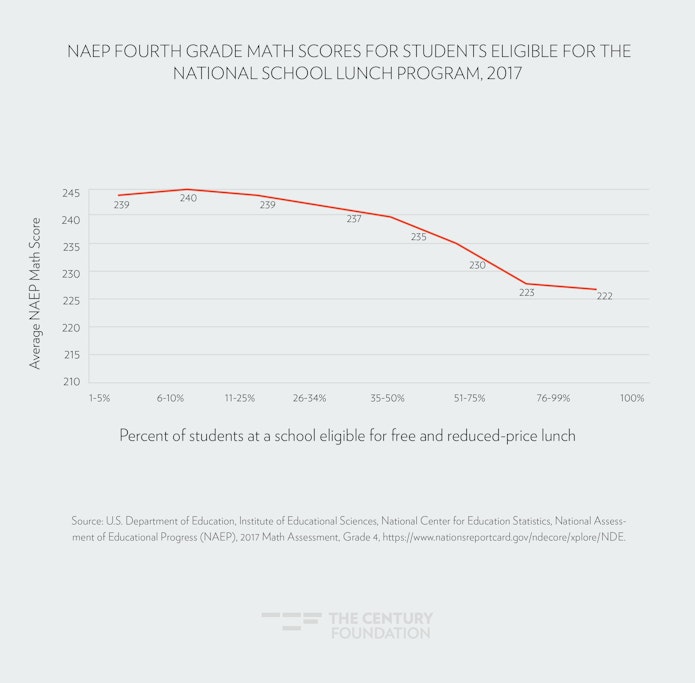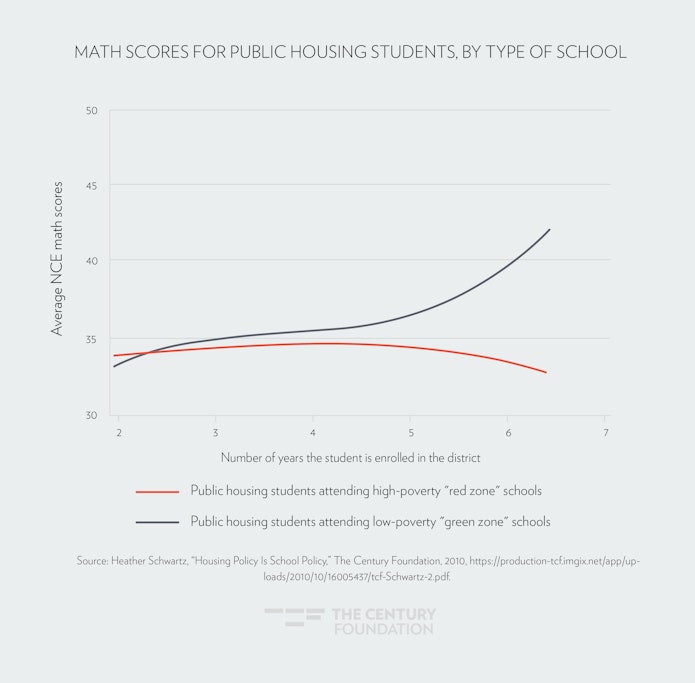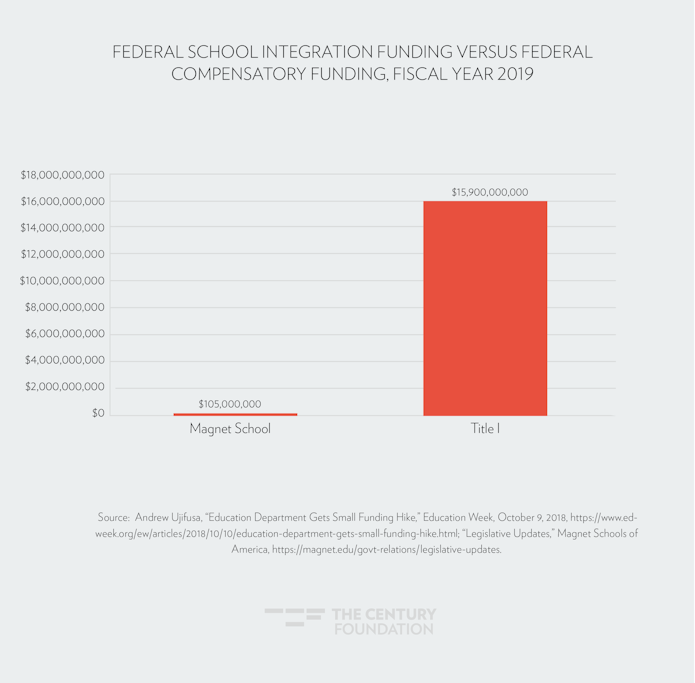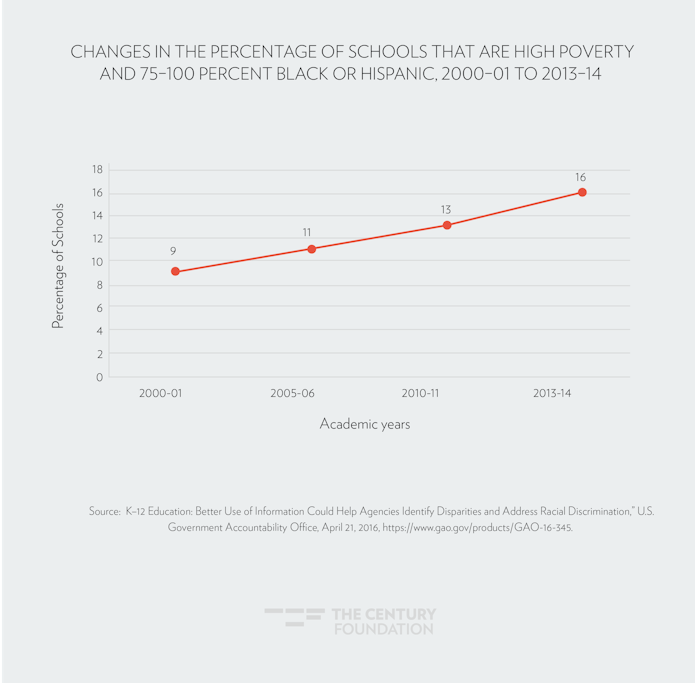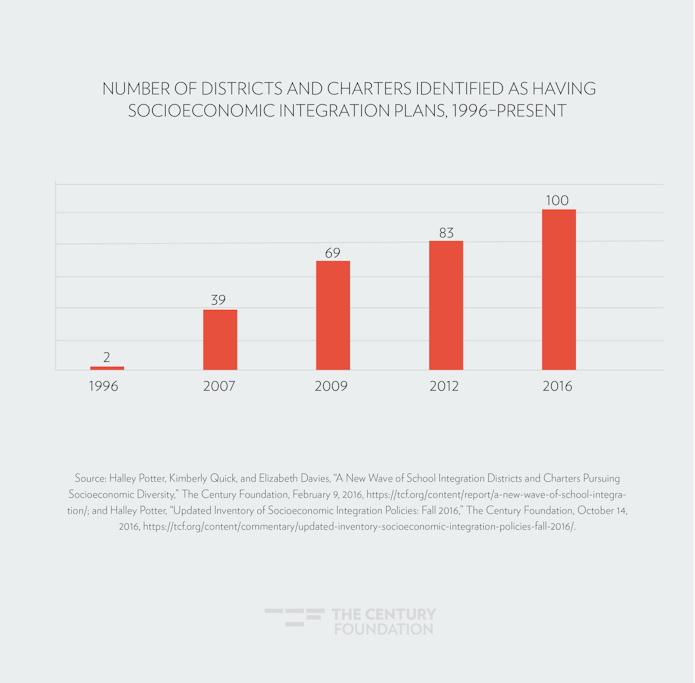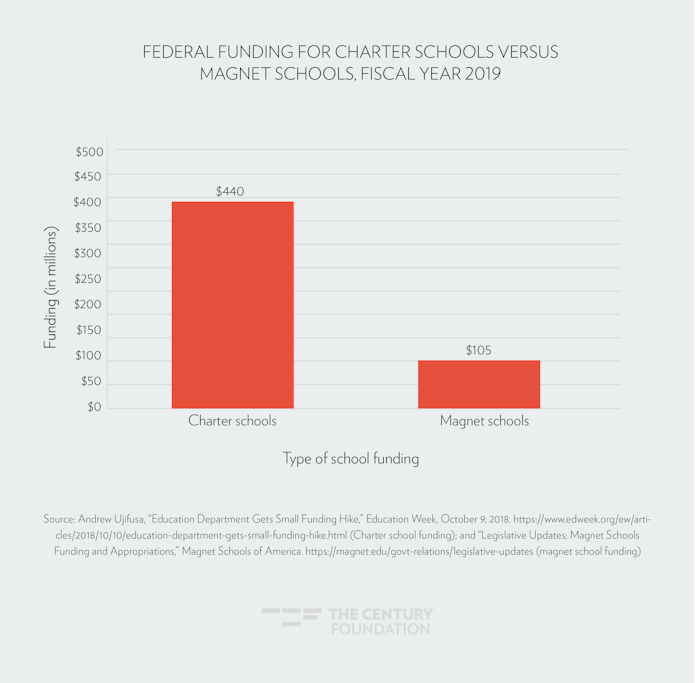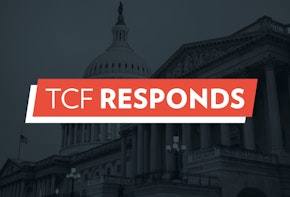At a time when our democracy is fractured along the fault lines of race, ethnicity, and religion, and when social mobility has stalled, high-quality integrated public schools could take us on a better path forward. Racial and socioeconomic school integration has proven to be one of the most powerful strategies known to educators to improve the lives of students and reduce national division.
Yet, in the face of growing school segregation, the federal government currently commits only a paltry amount of resources to support integration. To close the gap between the dire need for action and the absence of federal leadership, this report proposes a number of policy ideas for members of Congress to consider.
The first part of this report reviews the research on the powerful academic, cognitive, civic, socioemotional, and economic benefits of school integration. The second part outlines the evidence showing rising school segregation, and the relatively weak medicine the federal government currently brings to the problem; this section, however, also details some pockets of hope: a growing number of school districts that are taking steps to reduce segregation, as well as a few emerging federal and state proposals. The third and final part lays out long-term, medium-term, and short-term sets of policy initiatives that could make school integration a true federal priority, and, ultimately, a cornerstone in the renewal of the federal Elementary and Secondary Education Act, known as the Every Student Succeeds Act (ESSA).
The Benefits of School Integration
School integration, by race and socioeconomic status, goes to the very purpose of public education in the United States: to promote social mobility in the economy and social cohesion in our democracy. At the same time, school integration offers a third benefit: it is among the most cost-effective ways of promoting better outcomes for students. This report takes each of these benefits in turn.1
Social Mobility and Social Justice: How School Integration Promotes Academic and Cognitive Benefits, Particularly for Disadvantaged Students
Students in socioeconomically and racially diverse schools have stronger academic outcomes, on average, than students in schools with concentrated poverty. This is true even after students’ individual socioeconomic status is taken into account.
- Students in integrated schools have higher average test scores. On the 2017 National Assessment of Educational Progress (NAEP) given to fourth-graders in math, for example, low-income students attending schools that are more affluent scored roughly two years of learning ahead of low-income students in high-poverty schools.2 (See Figure 1.) Controlling carefully for students’ family background, another study found that students in mixed-income schools showed 30 percent more growth in test scores over their four years in high school than peers with similar socioeconomic backgrounds in schools with concentrated poverty.3
Figure 1
- Students in integrated schools are more likely to enroll in college. When comparing students with similar socioeconomic backgrounds, students at schools with high average socioeconomic status are 68 percent more likely to enroll at four-year colleges than their peers at schools with low average socioeconomic status.4
- Students in integrated schools are less likely to drop out. Dropout rates are significantly higher for students in segregated, high-poverty schools than for students in integrated schools.5 During the height of desegregation in the 1970s and 1980s, dropout rates decreased for minority students, and the greatest decline in dropout rates occurred in districts with the greatest reductions in school segregation.6
- Integrated schools help to reduce racial achievement gaps. The racial achievement gap in K–12 education closed more rapidly during the peak years of school desegregation in the 1970s and 1980s than they have overall during the more recent era in which desegregation policies were dismantled.7 More recently, black and Latinx students had smaller achievement gaps when compared with white students on the 2007 and 2009 National Assessment of Educational Progress when they were less likely to be stuck in high-poverty school environments.8 The gap in SAT scores between black and white students is also larger in segregated districts: one study showed that changing from an environment of complete segregation in a school district to one of complete integration would reduce the SAT score disparity by as much as one quarter.9
- Integrated classrooms encourage critical thinking, problem solving, and creativity. Diverse classrooms, in which students learn cooperatively alongside those whose perspectives and backgrounds are different from their own, are beneficial to all students, including middle-class white students, because they promote creativity, motivation, deeper learning, critical thinking, and problem-solving skills.10
Social Cohesion and Combating Racism: How School Integration Produces Civic and Socioemotional Benefits for All Students
Racially and socioeconomically diverse schools offer students of all racial and socioeconomic backgrounds important socioemotional benefits by exposing them to peers of different backgrounds. The increased tolerance and cross-cultural dialogue that result are beneficial for civil society.
- Attending a diverse school can help reduce racial bias and counter stereotypes. Children are at risk of developing stereotypes about racial groups if they live in and are educated in racially isolated settings. By contrast, when school settings include students from multiple racial groups, students become more comfortable with people of other races, which leads to a dramatic decrease in discriminatory attitudes and prejudices.11
- Students who attend integrated schools are more likely to seek out integrated settings later in life. Integrated schools encourage relationships and friendships across group lines.12 According to one study, students who attend racially diverse high schools are more likely to live in diverse neighborhoods five years after graduation.13
- Integrated classrooms can improve students’ satisfaction and intellectual self-confidence. Research on diversity at the college level shows that when students have positive experiences interacting with students of other backgrounds and view the campus racial and cultural climate as affirming, they emerge with greater confidence in their own academic abilities.14
- Learning in integrated settings can enhance students’ leadership skills. A longitudinal study of college students found that the more often first-year students were exposed to diverse educational settings, the more their leadership skills improved.15
Cost-Effectiveness: How School Integration Produces Economic Benefits
Providing more students with integrated school environments is a cost-effective strategy for boosting student achievement and preparing students for work in a diverse global economy.
- School integration efforts produce a high return on investment. According to one recent estimate, reducing socioeconomic segregation in our schools by half would produce a return on investment of three to five times the cost of the programs.16
- Attending an integrated school can be a more effective academic intervention than receiving extra funding in a higher-poverty school. A 2010 study of students in Montgomery County, Maryland, found that students living in public housing randomly assigned to lower-poverty “green zone” neighborhoods and schools outperformed those assigned to higher-poverty “red zone” neighborhoods and schools in math and reading, even though the higher-poverty schools received $2,000 extra funding per pupil.17 (See Figure 2.)
Reducing socioeconomic segregation in our schools by half would produce a return on investment of three to five times the cost of the programs
Figure 2
- School integration promotes more equitable access to resources. Integrating schools can help to reduce the disparities in access to well-maintained facilities, highly qualified teachers, challenging courses, and private and public funding.18
- Diverse classrooms prepare students to succeed in a global economy. In higher education, university officials and business leaders argue that diverse college campuses and classrooms prepare students for life, work, and leadership in a more global economy by fostering leaders who are creative, collaborative, and able to navigate deftly in dynamic, multicultural environments.19
The Current State of School Integration
Even though there is a strong social science consensus among educators and researchers that school integration is better for children than school segregation, legislators and other policymakers have not taken sufficient action to promote school diversity. The absence of strong federal efforts in the face of a decades-long trend of rising school segregation is particularly troublesome. Thankfully, a number of courageous local leaders have taken steps to embrace diversity, pursuing efforts that are deserving of federal support.
Anemic Federal Efforts
There was a time when the federal government played a powerful role in desegregating schools, particularly in the South. Following the 1954 U.S. Supreme Court decision in Brown v. Board of Education, Southern states resisted integration for more than a decade. But districts began to integrate after Congress passed key provisions in a pair of laws in the mid-1960s: Title VI of the 1964 Civil Rights Act, which made it illegal for districts receiving federal funding to discriminate based on race; and Title I of the 1965 Elementary and Secondary Education Act, which for the first time provided substantial federal aid to education. Federal administrators used the threat of withholding Title I funds to make Southern schools the most desegregated in the nation.
However, this political will began to fade in the 1970s, as whites resisted desegregation efforts, often violently. Congress passed an anti-integration rider on appropriations legislation, forbidding the use of federal funds for transportation to desegregate.20 Efforts to desegregate shifted to a more politically palatable approach: federal funding for magnet schools, which used special themes (such as arts or sciences) or teaching approaches (such as Montessori) to voluntarily attract white, middle-class families into schools in minority and high-poverty neighborhoods.21
In fiscal year 2019, the federal government appropriated just $105 million for magnet schools compared with $15.9 billion for the Title I program of compensatory education for high-poverty schools.
When properly structured, these magnet school programs can be effective in promoting diversity and improving outcomes for students. But federal support for magnet schools remains very modest. In fiscal year 2019, the federal government appropriated just $105 million for magnet schools compared with $15.9 billion for the Title I program of compensatory education for high-poverty schools.22 (See Figure 3.)
Figure 3
This lack of any serious federal legislative commitment to desegregation has been accompanied by a judicial pullback: beginning in the late 1980s and early 1990s, judges began making it easier for school districts to be declared “unitary,” meaning they have done enough to desegregate and are released from judicial desegregation orders. On top of that, the U.S. Supreme Court under Chief Justice John Roberts struck down two voluntary racial integration programs in Louisville and Seattle in 2007, further chilling efforts to integrate by race.23
Rising School Segregation
Given the federal legislative and judicial pullback on school diversity, it was highly predictable that schools would re-segregate. According to a 2016 report from the Government Accountability Office, the percentage of schools in which 75–100 percent of students were low-income and black or Hispanic grew from 9 percent in 2000–01 to 16 percent in 2013–14.24 (See Figure 4.)
Figure 4
Pockets of Hope: Grass-Roots Efforts to Promote School Diversity
In the face of a federal retreat from desegregation and rising levels of segregation, a small but growing number of school districts are fighting back to create high-quality integrated schools for their students. Although the Supreme Court’s decision in 2007 curtailed the ability of school districts to use the race of individual students to pursue voluntary integration efforts, it left open the door to considering the racial makeup of neighborhoods, or the socioeconomic status of individual students.
Local Efforts
Since 1996, socioeconomic diversity plans have been something of a growth industry among school integration efforts. In 1996, The Century Foundation identified just two school districts educating 30,000 students; today, the number exceeds 100 districts and charter school networks, educating more than 4 million students. (See Figure 5.) Although charter schools are often more segregated than traditional public schools, there has been growing interest in creating “diverse-by-design” charter schools, whose growth The Century Foundation has also documented.25
Figure 5
These districts and charter schools pursuing socioeconomic diversity plans are located in thirty-two states—both red and blue—throughout the country. (See Figure 6.) The Century Foundation recently profiled nine of these districts: New York, NY; Chicago, IL; Hartford, CT; Dallas, TX; Jefferson County (Louisville), KY; Stamford, CT; Eden Prairie, MN; Champaign, IL; and Cambridge, MA.26
Seeking to support these local efforts for school diversity, some state and federal policymakers have begun to generate proposals for voluntary integration.
Figure 6
Locations of Identified Districts and Charters with Socioeconomic Integration Policies
State Efforts
Among the most promising state-level efforts are proposals in Maryland and New York.
- Maryland Proposals for School Diversity. In Maryland, former teacher and state senator Bill Ferguson, a Baltimore Democrat, has long sounded the alarm about the opportunity gap created and sustained by school segregation. In 2015, Ferguson introduced SB 683, legislation that would establish Next Generation Schools, which would be run with the explicit intent of creating socioeconomically integrated, multi-jurisdictional schools.27 The following year, Ferguson proposed legislation to create the Maryland Education Development Collaborative (EDCo), which would make recommendations to the State Board of Education, the General Assembly, and local school systems about ways to diversify schools.28 Currently, the state’s Kirwan Commission on Innovation and Excellence in Education recognizes the value of student and educator diversity when considering how to strengthen Maryland’s public schools.
- New York State Integration Project—Professional Learning Community. To tackle school segregation and chronic school underperformance simultaneously, in 2015, then-New York State education commissioner John King (who later served as U.S. secretary of education) established the Socioeconomic Integration Pilot Program. Research suggests that school integration and magnet schools can be among the most effective school turnaround efforts.29 The program, which is still in existence but now called the New York State Integration Project, uses school-improvement funding from the federal government to turn around struggling schools by creating innovative and attractive magnet programs. According to Assistant Commissioner Ira Schwartz, the grant program aims to increase socioeconomic, racial, and ethnic diversity in schools, as well as encourage a better mix of students who have disabilities or are learning English. A portion of the funding, roughly $50,000 to $70,000 per district, is used to provide district leaders with education, training, and support as part of what the state describes as a “professional learning community” to pursue the best policies and practices for school integration.30 The first phase of grants are noncompetitive, with funds available for each of the eligible districts (which were selected based on criteria including having high levels of within-district or between-district segregation), if they choose to participate. The grants have proven popular.31 After this first phase of grants, interested districts can enter a competitive process to apply for more funding for implementation.
Federal Efforts
In recent years, a few federal policymakers have made important suggestions to reduce school and housing segregation. Among the leading federal proposals are:
- the Strength in Diversity Act, a proposal for $120 million in grants to voluntary efforts to integrate by race and socioeconomic status;
- congressional efforts to eliminate anti-integration riders on appropriations prohibiting spending on transportation; and
- proposals from Senator Warren and Senator Booker to reduce housing segregation.
We discuss each of these proposals further below in the context of several ideas we propose for beefing up federal integration efforts.
A Federal Agenda for School Integration
Building on existing local, state, and federal proposals to integrate, what sorts of proposals should Congress consider in order to meaningfully move forward on school diversity? Below, we outline eight ideas that fall into three buckets: big and bold ideas for long-term reform; meaningful and important ideas for the near future; and low-hanging fruit that policymakers should pluck immediately. These proposals are meant to supplement the excellent set of legislative and regulatory proposals recently outlined by the National Coalition on School Diversity.32
Three Big and Bold Ideas for the Long Term
1. Increase Title I Funding and Authorize $500 Million of that Funding for School Integration
Title I of the 1965 Elementary and Secondary Education Act is the primary means by which the federal government provides aid to school districts, with a focus on those educating low-income students. Title I does not provide aid directly for the education of individual poor students but rather provides “funds to areas with concentrations of poverty.”33 Research finds that money can have an important impact on raising student achievement.34 The case for expanding Title I is strong, and we advocate increased funding. Having said that, there is a compelling case that some portion of new Title I funds should be allocated specifically for school integration. Research suggests that school integration efforts can be a highly effective way of producing educational gains for students—sometimes even more cost-effective than compensatory spending, as Heather Schwartz’s study of Montgomery County, Maryland public schools suggested. (See Figure 2 above.)
School integration efforts can be a highly effective way of producing educational gains for students—sometimes even more cost-effective than compensatory spending.
Current levels and allocations of federal government spending on Title I do not comport with the research on the effectiveness of school integration efforts. As noted above, Title I allocates $15.9 billion in fiscal year 2019 for compensatory education in high-poverty schools, meant to mitigate the effects of poverty and school poverty concentrations, while the federal government allocated only $105 million for school integration efforts in the form of the Magnet Schools Assistance Program. (See Figure 3, above.) Does it really make sense for the federal government to allocate 151 times as much money to addressing the effects of poverty and concentrated poverty as it does to supporting initiatives that prevent or undo concentrations of poverty in the first place?
Integration programs—including magnet schools, school rezoning to promote diversity, districtwide “controlled choice” plans that combine choice with civil rights protections, and interdistrict integration efforts such as transfer programs—deserve more federal support. Although they are cost-effective in improving the public good, the launching of well-designed integration programs still requires the expenditure of funds. Money is needed, for example, to help voluntarily transport children from different neighborhoods to attend school together. Likewise, because integration is most effective when families have an affirmative incentive to attend an integrated school (because of a special magnet theme, or teaching approach), funds are needed for equipment and professional development around particular themes (such as STEM or the performing arts) or pedagogical approaches. On average, specialized magnet programs cost about 10 percent more to deliver than general education in a traditional public school setting.35
Because we support increases—rather than decreases—in Title I funding, we recommend that Title I funding be increased by more than $500 million, with up to $500 million of the increase allocated to districts that wish to employ Title I funds for school integration. In this way, the traditional compensatory education function of Title I is held harmless. Allocating funds through Title I would avoid having districts compete against each other in order to participate, as they do under some other integration proposals. The allocation of Title I funding for school integration is analogous to what John King did in directing School Improvement Grant (SIG) funds toward the creation of the Socioeconomic Integration Pilot Program in New York.
The proposed $500 million allocation of Title I funds is modest enough in size to allow the U.S. Department of Education to quickly develop appropriate oversight protocols, but it is large enough to have a meaningful impact on school diversity. If successful, the allocation amount could be increased over time. Because most segregation in the United States is between school districts rather than within them,36 we recommend that the U.S. Department of Education prioritize requests to allocate funds for inter-district integration programs.
2. An Economic Housing Act to Integrate Neighborhood Schools
To address growing economic and racial segregation of schools, we also recommend that the Congress enact an Economic Fair Housing Act, which would seek to curtail exclusionary zoning policies that ban apartment buildings and other multi-dwelling units. Today, roughly three-quarters of American schoolchildren attend neighborhood public schools, that is, one to which they were zoned. Changes in housing policy that eliminate exclusionary zoning practices thus can help integrate the schools that serve these neighborhoods.37
Today, roughly three-quarters of American schoolchildren attend neighborhood public schools, that is, one to which they were zoned.
The idea behind an Economic Fair Housing Act, which is outlined more fully in a 2017 Century Foundation report, is straightforward.38 After the U.S. Supreme Court struck down racial zoning laws designed to promote racial segregation in 1917, jurisdictions rapidly adopted economically exclusionary zoning policies that banned apartment buildings and other multifamily units, in order to achieve much the same result. Today, exclusionary zoning is pervasive in the United States and has been found to exacerbate both economic and racial segregation. Jonathan Rothwell of Gallup and Douglas Massey of Princeton have found that “a change in permitted zoning from the most restrictive to the least would close 50 percent of the observed gap between the most unequal metropolitan area and the least, in terms of neighborhood inequality.”39
Just as it is illegal to discriminate in housing based on race, it should be illegal for municipalities to employ exclusionary zoning policies (such as banning apartment buildings, townhouses, or houses on modest-sized lots) that discriminate based on income and exclude the non-rich from many neighborhoods—and thus from their associated schools. At the individual housing unit level, free market forces would continue to discriminate by income, because some apartments and houses will inevitably retain their expensive price tags—that simply is what markets do. But government zoning policies should not artificially inflate prices further and abet this economic exclusion by rendering off limits entire communities by making it impossible to rent an apartment, live in a townhouse, or purchase a home on even a modest plot of land. Congress passed a similar federal law prohibiting zoning that discriminates against religious organizations in 2000.40
One alternative to a complete ban on exclusionary zoning would be a federal policy to reduce the amount of mortgage interest that a family can deduct in jurisdictions that practice exclusionary zoning, as the University of North Carolina’s John Boger has suggested.41 While this wouldn’t eliminate them, it would make them less desirable. Another variation would bar federal funding for infrastructure to municipalities that insist on exclusionary zoning policies. Congress should also strengthen the 1968 federal Fair Housing Act’s racial anti-discrimination policies.42
Although zoning is traditionally thought of as a local prerogative, versions of legislation attacking exclusionary zoning have become an important part of the federal dialogue on segregation. Last year, Senator Cory Booker (D-NJ) introduced the Housing, Opportunity, Mobility and Equity (HOME) Act to curtail exclusionary zoning. Under Booker’s proposal, states, cities, and counties receiving funding under the $3.3 billion federal Community Development Block Grant program for public infrastructure and housing would be required to develop strategies to reduce barriers to housing development and increase the supply of housing. Plans could include authorizing more high-density and multifamily zoning and relaxing lot size restrictions. The goal is for affordable housing units to comprise no less than 20 percent of new housing stock.43
Likewise, Senator Elizabeth Warren (D-MA) has proposed a comprehensive housing plan that includes a new $10 billion infrastructure program with powerful incentives to reduce exclusionary zoning rules, such as “minimum lot sizes or mandatory parking requirements.” As she explained in March 2019, “to even apply for these grants,” localities “must reform land-use rules to allow for the construction of additional well-located affordable housing units.”44 Warren has also called for making it illegal for landlords to discriminate against renters with federal housing vouchers.45
State-level legislative proposals have also questioned the once-dominant view that zoning is strictly a local matter. Californians have recently debated legislation to reduce exclusionary zoning, particularly near mass transit hubs.46 Spurred in part by affordability concerns, policymakers in Massachusetts and Seattle have also considered proposals to curtail exclusionary zoning.47 Significantly, Minneapolis recently became the first major city to adopt a proposal to end single-family zoning restrictions entirely.48
3. Federal Pre-Clearance of Efforts of School Districts to Secede
School district boundaries and school zones within districts both too often perpetuate racial and socioeconomic segregation. Recently, a growing number of communities—at least seventy-one since 2000, according to research from EdBuild—have attempted to split from their parent school districts, often yielding massive funding inequities and allowing wealthier and whiter districts to isolate themselves and their resources from students with greater need.49 In Ohio, for example, the Monroe Local School District was created in 2000 after breaking away from Middletown City School District. In 2015, the median price for an owner-occupied home in Monroe was $159,200, or 73 percent higher than it would be in Middletown; at the same time, the median household income in Monroe was 95 percent higher than that of the neighboring city it had left behind.50 The exclusionary intent behind many of these school district secession movements is only thinly veiled: in Gardendale, Alabama, for example, a pro-secession organizer openly complained that the school population looked “different” from those that attend the sporting or religious gatherings in her more insular neighborhoods.51 Currently, of the thirty states that have secession laws on the books, only nine require a study of the funding impact of such an action, and just six require consideration of a succession’s effects on racial or socioeconomic segregation or student equity.52 We recommend that Congress adopt a requirement for federal preclearance of major district boundary changes secessions in order to better protect low-income children and children of color from further disinvestment due to discriminatory intent or effect. This system could operate similarly to Section 5 of the Voting Rights Act, but would be designed to be a “bail-in” system, thus following the Supreme Court’s holding in Shelby County v. Holder.53 Under the Voting Rights Act, preclearance applied where a “test or device” was used to screen would-be voters and where fewer than half of the eligible voters exercised that right or registered. Though the Supreme Court struck down Section 5’s coverage formula, federal courts can legally order that some jurisdictions with a proven history of discrimination are subject to additional oversight and approval. Jurisdictions covered by preclearance may not pursue plans that alter or eliminate voting procedures—including redistricting—without prior approval of a federal court or the U.S. Department of Justice. Plans are approved only if (1) there is no indicated intention to dilute minority voting power and (2) it does not have the effect of doing so, intended or not.54
The exclusionary intent behind many of these school district secession movements is only thinly veiled.
Such a preclearance framework could be useful in tackling school segregation. A documented history of de jure segregation and/or actual levels of segregation could qualify a school district for preclearance by either the Department of Justice or the Office of Civil Rights in the Department of Education. Redistricting, rezoning, or secession plans would be evaluated to ensure that policies did not have the intent or the effect of further segregating schools or otherwise creating separate and unequal educational systems for children according to race. Though preclearance is an aggressive tactic, Brown v. Board was rarely enforced with sufficient rigor, leaving America with an educational landscape that flies in the face of both its legal holdings and moral principles.
Two Meaningful and Important Ideas for the Near Future
1. Strength in Diversity Act
In September 2018, Congresswoman Marcia Fudge (D-OH) and Senator Chris Murphy (D-CT) introduced the Strength in Diversity Act. The bill would authorize $120 million in grants to districts for “voluntary community-driven strategies” to reduce school segregation.55 Fudge and Murphy introduced an earlier version of the bill in July 2016 under the name the Stronger Together School Diversity Act, with support from major nonprofit, labor, and advocacy organizations, including the American Federation of Teachers, the National Education Association, the Education Law Center, and the NAACP.56
The bill allow grantees to adopt creative, tailored, evidence-based solutions to segregation. If passed, the bill would allow grantees to use funds for a variety of purposes: to study segregation within their region; evaluate current policies and develop evidence-based plans; revise school boundaries or establish equitable public school choice zones; create and expand innovative and magnetic school programs that would appeal to a diverse group of families; and recruit and train teachers that could support these schools and work with a diverse student population.
Adoption of the Strength in Diversity Act—the most prominent legislative effort to support school integration—would represent an enormous step forward for the country.
2. Double Federal Magnet School Funding from $105 Million to $210 Million
The federal Magnet Schools Assistance Program—the primary existing vehicle of federal support for school integration—was allocated a modest $105 million in fiscal year 2019.57 By contrast, charter schools, which research suggests has even higher levels of segregation than traditional public schools, receive four times as much federal support ($440 million in fiscal year 2019).58 (See Figure 7.) This disparity exists despite the fact that magnet schools and charter schools educate comparable numbers of students. (Magnet schools educate 3.5 million students, while charters educate 3.1 million.)59
Figure 7
We are by no means opposed to charter schools; indeed, we believe that, with the proper incentives, charter schools can be a vehicle for school integration (see discussion below). But magnet schools deserve much stronger federal support than they currently receive. Researchers have found that integrated magnet schools can improve outcomes for students; one high-quality study comparing magnet school lottery winners and losers in Connecticut, for example, found that attending a socioeconomically and racially integrated magnet school boosted achievement among middle school and high school students alike.60 Evidence also suggests many families want what magnet schools have to offer. A 2017 national survey found that 67 percent of magnet schools report having waiting lists.61Currently, federal magnet school funding applies only to schools that avoid selecting students through tests. We support that current federal policy.
To advance school integration efforts—and meet parental demand—we recommend that Congress double magnet school funding, from $105 million to $210 million. The funding increase should be coupled to strengthen accountability to ensure that magnet schools reduce racial and economic isolation.
Three Pieces of Low Hanging Fruit that Should Be Plucked Immediately (with No New Funding Required)
1. Remove Section 426 of General Education Provision Act (GEPA) which Prohibits Federal Funding for Transportation to Promote Integration
Since at least 1974, Congress has consistently included riders on appropriations bills that prohibited federal funding from going toward transportation for school integration purposes, undermining local control and flexibility. The anti-integration riders mean, for example, that the districts participating in the New York School Integration Project, which uses Title I funds, may not spend those federal funds to support transportation as part of a school improvement strategy designed to desegregate schools. A bipartisan coalition of elected officials has regularly sought to appease white constituents uneasy about their children being bused into predominantly black neighborhoods.62 Efforts to strike these provisions failed as recently as 2017, when Congressman Bobby Scott (D-VA) unsuccessfully championed their removal.
Finally, in September 2018, after advocacy from civil rights and education groups, Congress reached a funding agreement that included removal of Sections 301 and 302 anti-integration riders from the budget. Despite this positive movement, however, Section 426 of the General Education Provisions Act remains, essentially echoing the provisions in the now eliminated appropriations riders. We believe Congress should remove this stain.
2. Remove Title I Funding Penalty for School Integration
As the National Coalition on School Diversity has noted, today, Title I’s funding priority for high-poverty schools can have the unintended consequence of discouraging integration in districts where an effort to reduce segregation could put a school below the Title I threshold for eligibility. We join the National Coalition’s call to “recalibrate the Title I funding formula so it does not penalize school districts or schools that seek to pursue integration.”63 It is critical to eliminate the perverse incentive to segregate, by creating a safe harbor for schools where integration efforts could risk the loss of Title I funds.
3. Make Diversity and Teacher Voice Priorities in the Charter Schools Program
The original idea for charter schools, as articulated by teacher union leader Albert Shanker in the late 1980s, was to create new public schools where teachers would be able to take on leadership roles and try out different teaching methods, students of diverse backgrounds would come together without rigid neighborhood attendance zones, and lessons would be shared to improve public education more generally.64 In practice, however, few charter schools today live up to this vision. Charter schools are more likely than traditional public schools to have either high-poverty or low-poverty enrollment (more than 75 percent or less than 25 percent of students eligible for free or reduced-price lunch, respectively), and less likely to be economically integrated.65 Charter schools also have higher rates of racial isolation than traditional public schools, with 17 percent of charter schools enrolling student bodies that are at least 99 percent students of color, compared to 4 percent of traditional public schools.66 And only 11 percent of charter schools are unionized.67
Lawmakers can reclaim the original intended power of charters to be laboratory schools for a diverse democracy, by adding priorities for diversity and teacher voice into the federal Charter Schools Program (CSP), which was reauthorized in 2015 under Title IV of the Every Student Succeeds Act (ESSA). In the 2019 appropriations, Congress allotted $440 million in funding for charter schools, a 10 percent increase over the previous year, even as overall education funding saw a decline.68 CSP is a large pot of money that could be better put to use to increase the number of seats available in racially and socioeconomically integrated schools that promote democracy. There are a number of ways that policymakers can amend CSP to help achieve this goal:
- Make enrolling diverse student bodies an explicit part of the purpose of CSP, alongside its current priorities, which include increasing the number of high-quality schools, evaluating the impact of charter schools and communities, and expanding opportunities for underserved students.
- Expand priorities for diversity. CSP currently includes a priority in the grants to charter management organizations (CMOs) that “plan to operate or manage high-quality charter schools with racially and socioeconomically diverse student bodies” as one of four priorities named in the law.69 However, there is no comparable priority for the grants to state entities (which make up the bulk of CSP funding) that would encourage states to include a similar priority in their sub-grants to charter schools, nor is there a priority in the federal grants to individual charter school developers in states without state entity grants.
- Require submission of data on charter school demographics and analysis of impact on surrounding schools in both the state entity and CMO grants, and require the U.S. Department of Education to analyze charter schools’ impact on school integration as one of the outcomes of CSP.
- Give priority in the grants to state entities that uphold the right of charter school teachers to bargain collectively, including the option to participate in existing bargaining units or form a separate unit.70
Conclusion
At a time when American democratic values and public education are threatened, it is important to lift up and strengthen public schools that are serving our democracy well. A number of localities have stepped up to adopt policies to promote school diversity. But significant political and legal impediments stand in the way of achieving integrated schooling. The federal government has abdicated its commitment to civil rights. It is time to make school integration a cornerstone of the next iteration of the Elementary and Secondary Education Act.
Notes
- This section draws upon “The Benefits of Socioeconomically and Racially Integrated Schools and Classrooms,” The Century Foundation, https://tcf.org/content/facts/the-benefits-of-socioeconomically-and-racially-integrated-schools-and-classrooms/.
- National Assessment for Educational Progress (NAEP), NAEP Data Explorer, 2011, retrieved from nces.ed.gov/nationsreportcard/naepdata/; and C. Lubienski and S. T. Lubienski, “Charter, private, public schools and academic achievement: New evidence from NAEP mathematics data,” National Center for the Study of Privatization in Education, Teachers College, Columbia University, January 2006 (rule of thumb that 10 NAEP points equates to roughly a year in learning).
- G. Palardy, “Differential school effects among low, middle, and high social class composition schools,” School Effectiveness and School Improvement 19, no. 1 (2008): 37.
- G. J. Palardy, “High school socioeconomic segregation and student attainment,” American Educational Research Journal 50, no. 4 (2013): 714.
- R. Balfanz and N. Legters, “Locating the Dropout Crisis: Which High Schools Produce the Nation’s Dropouts? Where Are They Located? Who Attends Them?” Center for Research on The Education of Students Placed at Risk, Johns Hopkins University, September 2004, http://www.csos.jhu.edu/crespar/techreports/report70.pdf.
- R. A. Mickelson, “Twenty-first Century Social Science Research on School Diversity and Educational Outcomes,” Ohio State Law Journal 69 (2008): 1173–228; Geoffrey D. Borman and Maritza Dowling, “Schools and Inequality: A Multilevel Analysis of Coleman’s Equality of Educational Opportunity Data,” Teachers College Record 112, no. 5 (2010).
- Gary Orfield, “Schools More Separate: Consequences of a Decade of Resegregation,” The Civil Rights Project, Harvard University, July 2001, http://civilrightsproject.ucla.edu/research/k-12-education/integration-and-diversity/schools-more-separate-consequences-of-a-decade-of-resegregation/orfield-schools-more-separate-2001.pdf.
- A. Mantil, A. G. Perkins, and S. Aberger, “The challenge of high-poverty schools: How feasible is socioeconomic school integration?” in The Future of School Integration: Socioeconomic Diversity as an Education Reform Strategy, ed. Richard D. Kahlenberg (New York: The Century Foundation Press, 2012), 155–222.
- D. Card and J. Rothstein, “Racial Segregation and the Black-White Test Score Gap,” Working Paper 12078, The National Bureau of Economic Research, March 2006, https://www.nber.org/papers/w12078.pdf.
- S. E. Page, The Difference: How the Power of Diversity Creates Better Groups, Firms, Schools, and Societies (Princeton, N.J.: Princeton University Press, 2008), http://press.princeton.edu/titles/8757.html; M. Chang, “The Educational Benefits of Sustaining Cross-Racial Interaction among Undergraduates,” Journal of Higher Education 77, no. 3 (May/June 2006): 430, http://muse.jhu.edu/journals/jhe/summary/v077/77.3chang.html; M. J. Chang, “The Positive Educational Effects of Racial Diversity on Campus,” in Diversity Challenged: Evidence on the Impact of Affirmative Action, ed. G. Orfield and M. Kurlaender (Cambridge, Mass.: Harvard Education Publishing Group, 2001): 175–86, http://eric.ed.gov/?id=ED456190; M. Chang et al., ed., Compelling Interest; P. Y. Gurin, “Expert Witness Report in Gratz et al. v. Bollinger et al,” 1998, http://diversity.umich.edu/admissions/legal/expert/gurintoc.html; K. Phillips, “How Diversity Makes Us Smarter,” Scientific American 311, no. 4 (October 2014), http://www.scientificamerican.com/article/how-diversity-makes-us-smarter/; A. L. Antonio, M. J. Chang, K. Hakuta, D. A. Kenny, S. Levin, and J. F. Milem, “Effects of racial diversity on complex thinking in college students,” Psychological Science 15, no. 8 (2004): 507–10; Brief of Amicus Curiae 553 Social Scientists, Parents Involved v. Seattle School District 551 U.S. 701 (2007) (No. 05-908); P. Marin, “The educational possibility of multi-racial/multi-ethnic college classrooms,” in Does diversity make a difference? Three research studies on diversity in college classrooms (Washington, D.C.: American Council on Education & American Association of University Professors, 2000), 61–68.
- R. Bigler, and L. S. Liben, “A developmental intergroup theory of social stereotypes and prejudices,” Advances in Child Development and Behavior 34 (2006): 39–89; T. F. Pettigrew and L. R. Tropp, “A Meta-Analytic Test of Intergroup Contact Theory,” Journal of Personality and Social Psychology 90, no. 5 (2006): 751–83, http://www.iaccp.org/sites/default/files/pettigrew_tropp_2006_contact_theory_0.pdf. See also J. Boisjoly, G. J. Duncan, M. Kremer, D. M. Levy, and J. Eccles, “Empathy or antipathy? The impact of diversity,” American Economic Review 96, no. 5 (2006): 1890–1905.
- “Brief of the American Educational Research Association et.al. as amici curiae in Support of Respondents in Fisher v. University of Texas at Austin”; T. F. Pettigrew and L. R. Tropp, “A Meta-analytic Test of Intergroup Contact Theory,” Journal of Personality and Social Psychology 90, no. 5 (2006): 751, http://www.iaccp.org/sites/default/files/pettigrew_tropp_2006_contact_theory_0.pdf; T. F. Pettigrew and L. R. Tropp, “How Does Intergroup Contact Reduce Prejudice? Meta‐analytic Tests of Three Mediators,” European Journal of Social Psychology 38, no. 6 (2008): 922–34, https://www.researchgate.net/publication/229779236_How_Does_Intergroup_Contact_Reduce_Prejudice_Meta-Analytic_Tests_of_Three_Mediators; K. Davies, L. R. Tropp, A. Aron, T. F. Pettigrew, and S. C. Wright, “Cross-Group Friendships and Intergroup Attitudes: A Meta-Analytic Review,” Personality and Social Psychology Review 15, no. 4 (2011): 332–51, http://psr.sagepub.com/content/15/4/332.abstract.
- K. J. R. Phillips, R. J. Rodosky, M. A. Muñoz, and E. S. Larsen, “Integrated schools, integrated futures? A case study of school desegregation in Jefferson County, Kentucky,” in From the Courtroom to the Classroom: The Shifting Landscape of School Desegregation, ed. C. E. Smrekar and E. B. Goldring (Cambridge, Mass.: Harvard Education Press, 2009), 239–70.
- N. F. P. Gilfoyle, “Brief of amici curiae: The American Psychological Association in Support of Respondents in Fisher v. University of Texas at Austin,” November 2, 2015, http://www.scotusblog.com/wp-content/uploads/2015/11/14-981bsacAmericanPsychologicalAssociation.pdf; “Brief of The American Educational Research Association, et.al. as amici curiae in Support of Respondents in Fisher v. University of Texas at Austin,” October, 30, 2015, http://www.scotusblog.com/wp-content/uploads/2015/11/14-981bsacAmericanEducationalResearchAssociationEtAl.pdf.
- “Brief of amici curiae: The American Psychological Association in Support of Respondents in Fisher v. University of Texas at Austin”; N. A. Bowman, “How Much Diversity is Enough? The Curvilinear Relationship Between College Diversity Interactions and First-year Student Outcomes,” Research in Higher Education 54, no. 8 (December 2013): 874-894, https://www.researchgate.net/publication/257658414_How_Much_Diversity_is_Enough_The_Curvilinear_Relationship_Between_College_Diversity_Interactions_and_First-Year_Student_Outcomes.
- Marco Basile, “The Cost-Effectiveness of Socioeconomic School Integration,” in The Future of School Integration: Socioeconomic Diversity as an Education Reform Strategy, ed. Richard D. Kahlenberg (New York: The Century Foundation Press, 2012), 127–54.
- Heather Schwartz, “Housing Policy Is School Policy,” The Century Foundation, 2010, https://production-tcf.imgix.net/app/uploads/2010/10/16005437/tcf-Schwartz-2.pdf.
- M. M. Chiu and L. Khoo, “Effects of Resources, Inequality, and Privilege Bias on Achievement: Country, School, and Student Level Analyses,” American Educational Research Journal 42, no. 4 (2005): 575–603, http://aer.sagepub.com/content/42/4/575.abstract; S. W. Raudenbush, R. P. Fotiu, and Y. F. Cheong, “Inequality of Access to Educational Resources: A National Report Card for Eighth- Grade Math,” Educational Evaluation and Policy Analysis 20 (1998): 253–67, http://www.ssicentral.com/hlm/techdocs/EEPA98.pdf; G. Orfield and C. Lee, “Why Segregation Matters: Poverty and Educational Inequality,” The Civil Rights Project, Harvard University, January 2005, http://civilrightsproject.ucla.edu/research/k-12-education/integration-and-diversity/why-segregation-matters-poverty-and-educational-inequality/orfield-why-segregation-matters-2005.pdf; Mark Schneider, “Do School Facilities Affect Academic Outcomes?” National Clearinghouse for Educational Facilities, November 2002, http://www.ncef.org/pubs/outcomes.pdf; A. S. Wells, B. Baldridge, J. Duran, R. Lofton, A. Roda, M. Warner, T. White, and C. Grzesikowski, “Why Boundaries Matter: A Study of Five Separate and Unequal Long Island School Districts,” The Center for Understanding Race and Education (CURE), Teachers College, Columbia University, July 2009, http://www.policyarchive.org/handle/10207/95995; M. Kalmijn and G. Kraaykamp, “Race, Cultural Capital, and Schooling: An Analysis of Trends in the United States,” Sociology of Education 69 (1996): 22–34, https://www.jstor.org/stable/2112721?seq=1#page_scan_tab_contents; J. Prager, D. Longshore, and M. Seeman, School Desegregation Research: New Directions in Situational Analysis (New York, NY: Plenum Press, 1986), https://www.springer.com/us/book/9780306421518?token=gbgen&wt_mc=GoogleBooks.GoogleBooks.3.EN; P. DiMaggio, “Cultural Capital and School Success: The Impact of Status Culture Participation on the Grades of U.S. High School Students,” American Sociological Review 47, no. 2 (April 1982): 189–201, https://campus.fsu.edu/bbcswebdav/institution/academic/social_sciences/sociology/Reading%20Lists/Stratification%20%28Gender%2C%20Race%2C%20and%20Class%29%20Copies%20of%20Articles%20from%202009/DiMaggio-ASR-1982.pdf.
- “Brief of Brown University et al. in Support of Respondents in Fisher v. University of Texas at Austin.”
- Matthew Delmont, Why Busing Failed: Race, Media, and the National Resistance to School Desegregation (Oakland, Calif.: University of California Press, 2016), 50–52.
- Christine H. Rossell, “Magnet Schools: No Longer Famous, but Still Intact,” Education Next 5, no. 2 (2005): 44–49, https://www.educationnext.org/magnetschools/.
- Andrew Ujifusa, “Education Department Gets Small Funding Hike,” Education Week, October 9, 2018. https://www.edweek.org/ew/articles/2018/10/10/education-department-gets-small-funding-hike.html.
- Parents Involved in Community Schools v. Seattle School District, 551 U.S. 701 (2007).
- “K–12 Education: Better Use of Information Could Help Agencies Identify Disparities and Address Racial Discrimination,” U.S. Government Accountability Office, April 21, 2016, https://www.gao.gov/products/GAO-16-345.
- Using a different methodology—requiring intentionality and resulting levels of diversity—The Century Foundation has identified 125 charter schools that qualify as diverse by design. See Halley Potter and Kimberly Quick, “Diverse-by-Design Charter Schools,” The Century Foundation, May 15, 2018, https://tcf.org/content/report/diverse-design-charter-schools/.
- “Stories of School Integration,” The Century Foundation, 2016, https://production-tcf.imgix.net/app/uploads/2016/10/13195652/StoriesOfSchoolIntegration.pdf.
- “State Board of Education—Synopsis of Bills #2, Information Only,” Maryland State Board of Education, February 22, 2015, http://www.autismconnectmd.com/stateboard/boardagenda/02242015/Tabs-K1-K2-LegislativeUpdate.pdf.
- “Next Generation Schools,” The New Deal, https://www.newdealleaders.org/next_generation_schools.
- See Richard D. Kahlenberg, “Turnaround Schools that Work: Moving Beyond Separate but Equal,” The Century Foundation, November 12, 2009. https://tcf.org/content/commentary/turnaround-schools-that-work-moving-beyond-separate-but-equal/.
- “Announcement of Funding Opportunity: 2018 Title I School Improvement Section 1003: New York State Integration Project—Professional Learning Community (NYSIP-PLC) Grant,” New York State Department of Education, http://www.p12.nysed.gov/funding/2018-title-1-nysip-plc/home.html.
- Christina Veiga and Monica Disare, “In a Growing Push to Promote School Integration, NY Announces New Round of Grants,” Chalkbeat, November 14, 2017, https://www.chalkbeat.org/posts/ny/2017/11/14/in-a-growing-push-to-promote-school-integration-new-york-announces-new-round-of-grants/.
- “A School Integration Policy Agenda for 2019 and Beyond,” The National Coalition on School Diversity, February 2019, https://school-diversity.org/2019policies/.
- “History of the ESEA Title I-A Formulas,” Congressional Research Service, July 17, 2017, https://www.everycrsreport.com/reports/R44898.html#_Toc488412045.
- See Bruce D. Baker, “How Money Matters for Schools,” Learning Policy Institute, December, 2017, 14; Bruce D. Baker, “Does Money Matter in Education?” 2nd ed., Albert Shanker Institute, 2016, i; and Rucker C. Johnson and Sean Tanner, “Money and Freedom: The Impact of California’s School Finance Reform,” Learning Policy Institute, Research Brief, February, 2018, 9.
- See Marco Basile, “The Cost Effectiveness of Socioeconomic School Integration,” in The Future of School Integration: Socioeconomic Diversity as an Education Reform Strategy, ed. Richard D. Kahlenberg (New York: The Century Foundation, 2010), 133–39.
- Charles T. Clotfelter, After Brown: The Rise and Retreat of School Desegregation (Princeton, N.J.: Princeton University Press, 2004), table 2.4.
- “Public School Choice Programs,” National Center for Education Statistics, https://nces.ed.gov/fastfacts/display.asp?id=6 (indicating that 13 percent of public school parents choose a school outside their neighborhood; roughly 10 percent use private school).
- Richard D. Kahlenberg, “An Economic Fair Housing Act,” The Century Foundation, August 3, 2017, https://tcf.org/content/report/economic-fair-housing-act/. See also Richard D. Kahlenberg, “The Walls We Won’t Tear Down,” New York Times, August 3, 2017, https://tcf.org/content/report/economic-fair-housing-act/.
- Jonathan Rothwell and Douglas Massey, “Density Zoning and Class Segregation in U.S. Metropolitan Areas,” Social Science Quarterly 91, no. 5 (2010): 1123–143, https://www.ncbi.nlm.nih.gov/pmc/articles/PMC3632084/.
- See Religious Land Use and Institutionalized Persons Act, U.S. Department of Justice. https://www.justice.gov/crt/religious-land-use-and-institutionalized-persons-act
- Richard Rothstein, The Color of Law: A Forgotten History of How Our Government Segregated America (New York: Liveright, 2017), 204–06 (referencing proposal by Jack Boger).
- Of course, the conditioning of federal funds would have to comply with the U.S. Supreme Court’s ruling in National Federation of Independent Business v. Sebelius, 567 U.S. 519 (2012).
- Richard Kahlenberg, “Taking on Class and Racial Discrimination in Housing: Cory Booker’s big idea to rein in exclusionary zoning,” The American Prospect, August 2, 2018, https://prospect.org/article/taking-on-class-and-racial-discrimination-housing.
- Elizabeth Warren, “My Housing Plan for America,” Medium, March 16, 2019.
- Rachel M. Cohen, “Elizabeth Warren Introduces Plan to Expand Affordable Housing and Dismantle Racist Zoning Practices,” The Intercept, September 28, 2018, https://theintercept.com/2018/09/28/elizabeth-warren-affordable-housing-bill.
- Richard Kahlenberg, “Reviving the Fair Housing Act at 50,” The American Prospect, April 11, 2018.
- Richard D. Kahlenberg, “Updating the Fair Housing Act to Make Housing More Affordable,” The Century Foundation, April 9, 2018, https://tcf.org/content/report/updating-fair-housing-act-make-housing-affordable/.
- Henry Grabar, “Minneapolis Confronts Its History of Housing Segregation: By doing away with single-family zoning, the city takes on high rent, long commutes, and racism in real estate in one fell swoop,” Slate, December 7, 2018, https://slate.com/business/2018/12/minneapolis-single-family-zoning-housing-racism.html.
- “Fractured: The Breakdown of America’s School Districts,” EdBuild, June 2017, https://edbuild.org/content/fractured/fractured-full-report.pdf.
- Ibid., 15.
- Ibid.; Kimberly Quick, “Segregation’s History Repeats Itself in North Carolina’s HB 514”, The Century Foundation, June 26, 2018, https://tcf.org/content/commentary/segregations-history-repeats-north-carolinas-hb-514/.
- Ibid.
- Shelby County, Alabama v. Holder, Attorney General, et al., 570 U.S. 529 (2013), https://www.supremecourt.gov/opinions/12pdf/12-96_6k47.pdf.
- Justin Levitt, “Who Draws the Lines?” All About Redistricting, Loyola Law School, http://redistricting.lls.edu/who-fed10.php.
- H.R.6722—Strength in Diversity Act of 2018, 115 Congress, https://www.congress.gov/bill/115th-congress/house-bill/6722; Andrew Ujifusa, “‘Strength in Diversity Act’ Would Create Federal Grants for Schools,’” Education Week, September 6, 2018, http://blogs.edweek.org/edweek/campaign-k-12/2018/09/strength-diversity-federal-grants-socioeconomic-racial-isolation-schools.html.
- “The Stronger Together School Diversity Act of 2016: Why Promoting Racial and Socioeconomic Diversity in our Public Schools is Vitally Important,” The National Coalition on School Diversity, https://school-diversity.org/pdf/Stronger_Together_School_Diversity_Act_of_2016_two-pager.pdf.
- “Legislative Updates: Magnet Schools Funding and Appropriations,” Magnet Schools of America, https://magnet.edu/govt-relations/legislative-updates.
- See “Characteristics of Traditional Public Schools and Public Charter Schools,” National Center for Education Statistics, April 2018, https://nces.ed.gov/programs/coe/indicator_cla.asp; and Ivan Moreno, “US Charter Schools Put Growing Numbers in Racial Isolation,” Associated Press, December 3, 2017, https://apnews.com/e9c25534dfd44851a5e56bd57454b4f5 (re segregation levels in charter schools). See also Andrew Ujifusa, “Education Department Gets Small Funding Hike,” Education Week, October 9, 2018, https://www.edweek.org/ew/articles/2018/10/10/education-department-gets-small-funding-hike.html (re charter school funding).
- “Fast Facts,” Magnet Schools of America,magnet.edu/files/Magnet.Schools.Fast_.Factsv2.Web_.pdf; Rebecca David and Kevin Helsa, “Estimated Public Charter School Enrollment, 2017–18,” National Alliance for Public Charter Schools, March 18, 2018, https://www.publiccharters.org/sites/default/files/documents/2018-03/FINAL%20Estimated%20Public%20Charter%20School%20Enrollment%2C%202017-18.pdf.
- See e.g. Robert Bifulco, Casey D. Cobb, and Courtney Bell, “Can Interdistrict Choice Boost Student Achievement? The Case of Connecticut’s Interdistrict Magnet Program,” Education Evaluation and Policy Analysis 31 (2009): 323–45.
- Magnet Schools of America, “Fast Facts,” magnet.edu/files/Magnet.Schools.Fast_.Factsv2.Web_.pdf.
- Mel Leonor, “Inside the Spending Deal That Will Fund the Educational Department,” Politico, September 14, 2018, https://www.politico.com/newsletters/morning-education/2018/09/14/inside-the-spending-deal-that-will-fund-the-education-department-340453; National Coalition on School Diversity to The Honorable Tom Cole and The Honorable Rosa DeLauro of the House Appropriations Committee, May 31, 2018, https://school-diversity.org/wp-content/uploads/2018/05/NCSD-Letter-on-Anti-Integration-Appropriation-Riders-5-31-18-House.pdf.
- “Crafting a Policy Agenda for 2019 and Beyond,” National Coalition on School Diversity, https://school-diversity.org/wp-content/uploads/2018/07/Policy-Handout_Draft6.pdf.
- Richard D. Kahlenberg and Halley Potter, A Smarter Charter: Finding What Works for Charter Schools and Public Education (New York: Teachers College Press, 2014).
- “Characteristics of Traditional Public Schools and Public Charter Schools,” National Center for Education Statistics, April 2018, https://nces.ed.gov/programs/coe/indicator_cla.asp.
- Ivan Moreno, “US Charter Schools Put Growing Numbers in Racial Isolation,” Associated Press, December 3, 2017, https://apnews.com/e9c25534dfd44851a5e56bd57454b4f5.
- “Unionized Charter Schools, 2016–17,” National Alliance for Public Charter Schools, 2018, https://www.publiccharters.org/sites/default/files/documents/2018-02/Unionized%20Charter%20Schools%202016-17_0.pdf.
- Department of Education, Fiscal Year 2018 Congressional Action, https://www2.ed.gov/about/overview/budget/budget18/18action.pdf.
- Elementary and Secondary Education Act of 1965, as amended by the Every Student Succeeds Act, 20 U.S.C. § 4305(b)(5)(A) (2018), https://legcounsel.house.gov/Comps/Elementary%20And%20Secondary%20Education%20Act%20Of%201965.pdf.
- Some states (Illinois, Maine, New Hampshire, Pennsylvania, and Washington) allow charter school teachers to bargain collectively but bar them from participating in the district union or other existing units. Other states currently ban all teachers from engaging in collective bargaining. See “Automatic Collective Bargaining Exemption” in Measuring Up to the Model: A Ranking of State Public Charter School Laws, 2019, National Alliance for Public Charter Schools, January 2019, https://www.publiccharters.org/our-work/charter-law-database/components/14.

